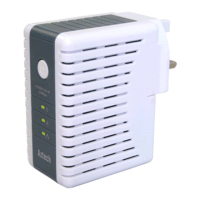
Do you have a question about the Aztech HL110E and is the answer not in the manual?
| Device Type | Powerline Adapter |
|---|---|
| Model | HL110E |
| Category | Adapter |
| Speed | Up to 200Mbps |
| Data Transfer Rate | 200 Mbps |
| Interface | Ethernet |
| Standards | HomePlug AV |
| Security | 128-bit AES Encryption |
| Data Rate | 200Mbps |
| Encryption | 128-bit AES |
| Operating Voltage | 100-240V AC |
| Operating Temperature | 0°C to 40°C |
| Storage Temperature | -20°C to 70°C |
| Humidity | 10% to 90% non-condensing |
| Type | HomePlug AV |
| Ports | 1 x Ethernet |
Disclaims warranties and limits liability for damages related to product use or inability to use.
Explains HomePlug AV functionality using electrical wiring for networking with digital signal conversion.
Details the function of each labeled component (A-F) on the HomePlug AV device.
Explains how to create a new HomePlug AV network using the Simple Connect button.
Details how to reset the Private Network Name to a random key using the Simple Connect button.
Explains how to add a new HomePlug AV device to an existing network using Simple Connect.
Explains how LED colors indicate connection speed and how to view rates in the utility.
Describes when the HomePlug AV enters power saving mode and the conditions for it.
Provides guidance and ideas on planning the HomePlug AV network setup.
Outlines the steps for physically connecting and setting up the HomePlug AV devices.
Explains how to install the utility software for configuration and monitoring.
Illustrates sharing internet connection with computers throughout the house.
Shows how to connect gaming consoles to the internet for online play.
Demonstrates streaming IP TV into a home entertainment system.
Guides on converging IP devices into a single network for high-tech lifestyle.
Details connecting HomePlug AVs from a twin pack for easy setup.
Explains adding a single pack HomePlug AV to an existing network.
Lists the minimum system requirements for installing and using the HomePlug AV Utility software.
Explains tasks in the Home tab like changing network name or upgrading firmware.
Details how to manually change the Private Network Name for device communication.
Explains how to change the network name for a directly connected device.
Describes changing network name for remote devices using their Device ID.
Allows simulating physical button presses for network functions via the utility.
Explains how to prioritize network traffic for specific applications.
Shows details of remote devices, including MAC addresses and connection rates.
Guides on how to upgrade the device firmware using the utility.
Answers common questions about compatibility, setup, and features.
Details FCC compliance for Class B digital devices and interference guidelines.
States compliance with European R&TTE directive 1999/5/EC.